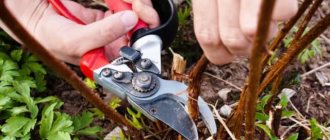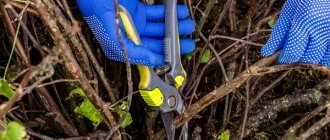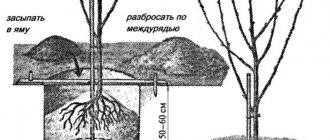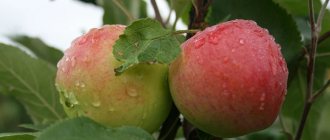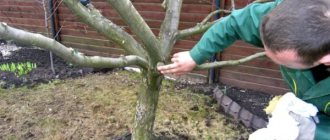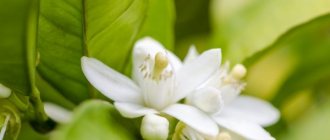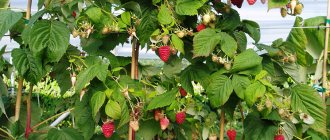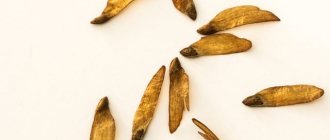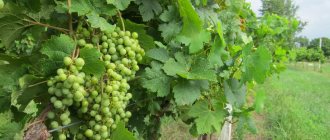How to choose a seedling for planting
Cherries can live up to 100 years and reach a height of up to 12, and some specimens up to 30 meters. Having planted cherries once, you can receive delicious “dividends” from it for the rest of your life. The main thing is to choose a seedling that will take root without problems.
Cherry seedlings
When buying a young tree, you need to pay attention to the following details:
1 The preferred place of purchase is the nursery where the tree was grown. If there are no nurseries nearby, then you can choose a seedling at a garden center. The most unreliable options that threaten the acquisition of mismatched items are purchasing via the Internet, at bazaars from resellers and summer residents.
2 The label is the “face” of the seedling. It should contain detailed information about the variety. If the seller has a passport (approbation certificate, test report) for the plant, this is the best option.
3 The age of the seedling is no more than three years.
4 Appearance of the seedling - the bark should be smooth, without any damage. The roots when cut are light and elastic (not brown rotten), without growths and cones. There should be three roots, each about 20 cm long.
5If a seedling is purchased in the spring, it must have buds; if in the fall, it must have foliage .
When choosing young cherries, pay attention to the seller and his qualifications. And also on the conditions in which the seedlings are stored.
Which seedlings are not recommended to buy?
It is not recommended to buy young trees that will require long transportation or acclimatization. Cherry is a “capricious” tree and there is no need to expose its seedlings to unnecessary stress.
This is what cancer can look like on the root of a plant
The local nursery, as already mentioned, is the most suitable place to buy a seedling, but why? Because a tree grown in these climatic conditions has a better chance of taking root and producing high yields than one brought from afar.
A zoned variety also has advantages in early fruiting, berry quality, regularity of fruiting, disease resistance and longevity of plantings.
If a seedling was grown in the south and planted in the central or northern regions, it will be of little use. It is quite easy to distinguish a southern seedling from the general mass - the tree itself is vigorous, but the root system is poorly developed. The lower buds of the tree have been removed.
Also, experts do not advise buying seedlings from which:
- There is no trace of grafting on the trunk . Such plants are most likely not varietal and begin to bear fruit late; the taste of the berries is average or low
- no branches . For such plants, crown formation will take a very long time.
- poor condition of the conductor . As the tree begins to grow, a weak conductor will have competitors from strong branches.
- two conductors - possible break in half and death of the tree with abundant fruiting
Cherry varieties
There are a huge number of varieties and types of cherries. They are classified:
- by the color of the berries (yellow, yellow with a red side, pink, dark red);
- to taste (sweet, sweet with sourness);
- according to the density of the pulp (tender, soft or dense crispy).
Early ripening
Their fragrant and juicy berries with excellent taste reach maturity in the 2-3rd decade of June. The best among the early varieties are:
Valery Chkalov . A productive, frost-resistant variety. It has a dessert purpose and is suitable for canning. Large fruits (7-9) g, collected on a small stalk, are heart-shaped with a dark red color. Berries with a large, semi-separable seed. Has average resistance to fungal diseases.
And the way . Frost-resistant, partially self-fertile, medium early-fruiting variety has an average yield and early ripening. The fruits are average 5-7 g, heart-shaped with roundness and a white point at the top. The color changes as it ripens from dark red to almost black. The stone is light brown, slightly pointed at the top, and sticks slightly to the pulp with medium density. If there is excess moisture, the fruits crack. The Iput cherry is resistant to fungal diseases. It begins to bear fruit in the 5th year.
Raditsa . The variety tolerates winter frosts well. High-yielding, but self-sterile, so a pollinator variety should grow nearby. The fruits are dark red in color. The tree is low-growing with a compact crown.
Orlovskaya amber . A variety of medium winter hardiness with good yield. The berries are average 5-6 g, with good taste, yellow-pink in color.
Mid-season
After the early varieties, the turn of the middle ones gradually comes:
Bull's heart . A variety with large pomegranate-colored fruits with hard-to-pull heart-shaped fruits weighing 8-10 g. Ripening occurs in the second half of June. The variety tolerates cold well and is resistant to diseases.
Fatezh . A medium-sized plant with small berries up to 5 g, but a stable yield. The variety is resistant to diseases. The fruits are pale scarlet in color and have slightly sour flesh.
Vasilisa . A low tree with mixed fruiting. The berries are large, up to 15 g, sweet with dense pulp. With good resistance to frost. It begins to bear fruit 3 years after planting.
Surprise . A variety with average frost resistance. Low damage from disease. Tolerates drought and heat well, but can get sunburn. Large berries 10 g dark red with sour pulp. Pollinators required.
Late
These varieties require more heat and time to ripen the fruit. They are finishing the cherry season:
Tyutchevka . Medium height. The harvest is stable. The berries are medium scarlet 6-7 g with red pulp. They tolerate transportation well. The plant is resistant to moniliosis. Ripens in early July.
Record holder . The tree is tall and productive. The berries are large, 8-10 g, creamy with a pink tint, the flesh is elastic, sweet, and has a medium seed. It is resistant to frost.
Regina . A low tree that begins to bear fruit in the 3rd year after planting. The fruits are dark red, large, 8-10 g, with a rich taste, suitable for transportation. They begin to ripen in mid-July. The plant is frost-resistant.
Napoleon . Tall tree. The fruits are large, 6-8 g, slightly oblong, heart-shaped, dark red (almost black) with dense pulp, which has a sweet taste with a barely noticeable sourness. Transported without compromising quality. Cherries are ready for harvest in early July.
By correctly comparing the characteristics of varieties, such as their flowering time, yield, winter hardiness, disease resistance, and soil requirements, you can grow an excellent harvest with a minimum of effort.
How to store a seedling before planting
You can plant cherries in both spring and autumn. Some gardeners buy young trees in the fall and plant them the following spring. If you bought a tree, but there is no opportunity to plant it yet, it needs to be stored in “comfortable” conditions.
A seedling placed in a trench for the winter
The tree must be stored in a shaded, cool place; it must be reliably protected from drying out and damage by rodents. To do this, they are first kept in water for 2 to 12 hours. And then, wrapped in a damp cloth, placed in a plastic bag or sprinkled with damp cloth.
If the tree is purchased in the fall, it needs to be buried until spring. To do this, make a shallow (50 cm) hole, one side of which has a slope of 45º. The seedling is placed on this side, after which the roots are sprinkled with earth, and the top is insulated with what is at hand - straw, fallen leaves, spruce branches, burlap, roofing felt.
Some gardeners use this storage system:
- The roots of the tree are covered with wet tyrsa . Then, using plastic film, a dense roll is formed.
- A tree with a root system sealed in this way can be stored until spring in a cellar or basement. It is also convenient to transport.
However, the best option is to plant the tree on the day of purchase, in a previously prepared hole.
Choosing a site for planting and preparing the hole
Cherries love the sun, warmth and space. Since it can grow very tall, this fact must be taken into account when choosing a place for planting - the tree should be at least 4-5 meters away from others so that there is no shading. If you plan to plant a large cherry orchard, the trees can be arranged in a checkerboard pattern.
The hole for planting cherries should be dug in a sunny place.
Other cherries (2-3 varieties) or, in extreme cases, cherries must grow nearby, because cherries are a cross-pollinated plant. The main thing is that the flowering period of the trees coincides.
The optimal place for planting is the south side of the garden, a place with a slight elevation (not a hill, but not a lowland), protected from the winds. If it is not possible to plant cherries in the south, the southwest or southeast will do. It is also a good idea to plant cherries on the south side of buildings or fences - this is excellent protection from north winds.
The soil must be fertile, but clay, peaty or sandy soil is not suitable. Also, the soil must be well aerated, moisture-absorbing and moisture-permeable. Even a slight stagnation of moisture is detrimental to cherries, so you need to ensure that there is no close groundwater at the planting site.
The hole for planting cherries is prepared in advance - several weeks in advance, this will allow the disturbed soil to settle. The dimensions of the planting hole are 50 cm deep and 80 cm wide.
At the bottom there should be a layer of soil mixture - fertile soil, compost or other organic fertilizer, as well as ammonium sulfate (2 kg / 2 buckets of soil), superphosphate (3 kg), ash (1 kg) and potash fertilizer (1 kg).
What is required to grow cherries in central Russia
Growing cherries in central Russia requires some attention. There are also subtleties here. A plant such as cherry certainly needs a place that will be completely protected from strong winds and well-lit during daylight hours. Plots of land that are unsuitable for planting cherries are located, as usual, in lowlands, where cold air is usually very often present, and also where there is standing groundwater. This crop develops very poorly in acidic soil. The required soil acidity in this case is pH = 6.5-7. Based on this, it is necessary to systematically lim the soil over several years. In extremely dry years, watering is essential.
When to plant?
You can plant cherries in spring or autumn, it all depends on the preferences and capabilities of the gardener. If planting occurs in the spring, you should not focus on a specific month. Spring can be early or late, and therefore it is important not to miss a good moment.
Early spring is a great time to plant fruit trees
On the one hand, the snow should already have melted, the soil should have dried out, and the temperature should not drop below 0º (even if a winter-hardy variety is planted). On the other hand, active movement of tree sap should not begin. If the leaves have already blossomed on the trees, you will have to wait until autumn to plant them.
Most gardeners prefer to plant cherries in the fall, as this time of year has the widest selection of varieties. But how correct is this?
A young, fragile tree almost immediately finds itself in unfavorable conditions, and its chances of survival are less than when planted in the spring, when the owner can monitor its development and condition throughout the season.
It is recommended to choose the time for planting cherries based on the location of the garden:
- in areas with a warm climate, young cherries are planted in the fall - in September-October . Or based on the weather - you need to have time to plant trees a few weeks before the soil freezes
- in areas with a cold , northern climate, the planting procedure can begin in early spring before the buds begin to swell
Proper planting of cherries is half the success. Therefore, the process must be approached with full responsibility.
Watering and mulching the soil
The plant most of all needs watering during the period of active shoot growth and fruit filling . Therefore, the first watering is carried out at the end of May, after flowering. The second - in mid-June, the third - in July, if the weather is dry. The third watering should be treated with caution: excessive moisture during fruit ripening can lead to cracking.
In September - early October, abundant watering is carried out in order to create reserves of moisture in the soil. Water consumption in this case is approximately 50–60 liters per m2, the soil should be saturated with moisture to a depth of 40 cm.
In order to prevent water evaporation, the soil in the circles around the trunk is mulched.
Grafted plantings regardless of the time of year
The planting hole, prepared in the fall or 2 weeks in advance, must be fenced with a roll of earth. Pour a couple of buckets of water that has been left in the sun into the hole.
Pegs are additional support for a young tree
A small mound of soil is formed in the middle of the hole (it can also be formed while the planting hole is being prepared) and the planting process begins:
1Free the tree, or rather its roots, from the packaging.
2 Leaves, if any, must be carefully removed - the plant loses excess moisture through the leaves. If the leaves are removed, the tree will “focus” on the process of formation, growth and strengthening of the root system.
3The roots need to be straightened and trimmed if necessary. Spread the roots over the surface of the mound.
4Supporting the seedling with one hand and shaking it periodically, you need to cover the roots with soil.
5When the roots are covered, you need to water the plant with several buckets of water. When the soil has finally settled, add more soil to such a level that after throttling, the root collar of the tree rises 3-5 cm above the ground surface.
6The ground in the tree trunk circle needs to be leveled and mulched using straw, peat, humus or special materials.
Drive a peg into the center of the planting hole - this will be an excellent support for the young tree until it takes root.
Care in spring, summer and autumn
Whitewashing is part of wood care
Cherries, if planted correctly, do not require any special care in the future. All activities are quite standard - watering, disease prevention, pest protection, pruning, fertilizing, etc.
In early spring, the trunks of seedlings and mature cherries need to be whitened. This way you can avoid sunburn of the bark when the spring sun begins to warm up. It is necessary to whitewash not only the trunk, but also the bases of the skeletal branches.
An important stage in caring for a seedling is removing weeds. Cherries do not tolerate any competition, which means that the tree trunk circle will need to be regularly cleared of unwanted neighbors. Simultaneously with weeding, the soil is loosened, which allows the roots of the tree to receive more oxygen.
If you don’t want to constantly remove weeds, you can resort to one of the many options to prevent their growth:
- Planting lawn grass with a shallow root system in a tree trunk circle. The grass will need to be trimmed regularly.
- Mulching the soil with materials that make it difficult for weeds to grow through. Pebbles, sawdust, or special weed covering materials are suitable.
- Planting ornamental plants in the tree trunk that will cover the soil. The main thing is that the plants are not demanding on soil nutrition, moisture and tolerate shade well.
If during the season the cherry tree grows basal shoots, it needs to be cut off without allowing it to grow.
Watering seedlings and mature trees
Watering cherries should not be abundant, but regular. It is enough to carry out the procedure 3-5 times per season . During particularly dry periods, the amount of watering can be increased, based on the condition of the tree.
The correct option for watering a fruit tree
The first watering can be organized in early spring, the second before flowering or during the formation of berries, the third to fifth after harvesting and further as necessary. Water consumption is 2 buckets of liquid for each year that the tree has lived.
A day after watering and after each rain, the soil in the tree trunk circle (if there is no permanent mulch) needs to be loosened. For these purposes, use a hoe or a hand cultivator. After loosening, the ground is again covered with mulch.
One of the most important waterings is before the onset of cold weather. Try to saturate the soil with water to a depth of 60-80 cm. This is a great way to increase the winter hardiness of a tree. This impregnation will also slow down soil freezing in winter.
Treatment against pests and diseases
Treatment of wood against pathogens and insects is carried out immediately after the air warms up to 18º. It is noteworthy that bacteria and fungi, as well as all kinds of pests, can overwinter both in the bark of a tree and in the soil around it. Therefore, spraying against insects should be carried out when insects have already emerged from the ground.
Spraying trees in spring
For preventive treatment, you can prepare a solution of 700 g of urea and 10 liters of water.
To repel pests, cherries can be treated with the following drugs:
- akarin
- agravertine
- fitover
- caviar-bio
The first spring treatment should be carried out before the buds begin to open. If the solution gets on the tree after sap flow begins, the buds may get a chemical burn.
Further treatments can be carried out if a specific disease or pest is detected. And the last processing of cherries occurs on the eve of winter.
To increase the resistance of a young tree to unfavorable conditions and chemical, biological, physical and climatic phenomena, during preventive treatment it can be additionally sprayed with Zircon or any other bioregulator. Thanks to this, root formation, growth, flowering and fruiting of cherries are intensified, and disease resistance is increased.
Attracting Pollinators
Bees are attracted to increase productivity. This is not a mandatory, but desirable stage of caring for cherries during the period when they begin to bloom. It's fairly easy to do and the results can be impressive.
Mustard attracts bees during flowering
To attract bees and organize high-quality pollination of cherry blossoms, you can resort to one of the methods:
1Plant honey plants, for example, mustard, in the garden or vegetable garden (if it is located in close proximity to the cherry plantings).
2Take a little honey, a tablespoon is enough, dilute it in a liter of water and sprinkle it on the tree. Insects from afar will sense a familiar smell and flock to it.
The bees that arrive to pollinate the cherry tree will provide the same “service” to other flowering trees in the garden.
Organic fertilizers
Organic fertilizers, such as humus and compost, are applied to the cherries in the spring. In the summer, in August, you can also feed the trees with organic fertilizers - mullein, a solution of chicken manure.
Compost is an excellent organic fertilizer
The need for each seedling and young cherry tree to be fertilized with organic matter is purely individual. It all depends on how much fertilizer was added to the planting hole, the age of the tree, the quality of the soil and even weather conditions.
Fertilizing with mineral fertilizers
Sweet cherries require minimal feeding. If there is too much fertilizer, the tree will “fatten” and many new shoots will appear, which will then have to be cut out. The optimal time for applying mineral fertilizers is autumn.
One of the types of mineral fertilizers
Some gardeners do not use mineral fertilizers in the first year or two after planting cherries. This is explained by the fact that fertilizers applied to the planting hole should theoretically satisfy the needs of the seedling. Especially when the soil in the garden is fertile.
However, it is recommended to apply nitrogen preparations already in the second year after planting cherries. But the need for potassium and phosphorus substances in a tree may arise in the third or fourth year of life.
Preparing trees for winter
After the harvest is harvested, the cherries are left alone until autumn, periodically watered and treated for diseases/pests if necessary.
Ordinary wood shavings are a good solution for insulating tree trunk circles
In autumn, when the leaves begin to turn yellow, you need to carry out a number of activities:
1 The last fertilizing with fertilizers followed by digging up the soil around the tree trunks to a depth of 8-10 cm.
2 Water the trees generously to ensure they are saturated with moisture before a long period without watering. It is especially important to carry out pre-winter water-recharging irrigation when the harvest was high and the autumn was dry.
3 Fallen leaves need to be collected, they can be burned, or if the leaves are healthy, they can be placed in a compost heap.
4 The last time to treat the tree with preparations, you can use one complex preparation against diseases and insects that are already settling in for the winter in the bark.
5 Whitewash like in spring.
The most important thing to do for a young cherry seedling is insulation. Even if a frost-resistant variety was planted, do not forget that cherries are still a southern plant.
It is better not to take risks and wrap the trunks of young trees with any breathable protective material - burlap, spruce branches, but using lutrasil or any other synthetic material for insulation is unacceptable, since the tree will rot underneath it.
It is advisable to wrap the crown of young cherries and tie them with a rope - this way a snow cap will not accumulate on it. But to protect the crown of grown cherries from damage, you will have to brush the snow off it manually.
The trunk circles of young and even adult plants must be mulched with peat for the winter.
Pruning (sanitary)
Cherry trees should be pruned twice a year. The first procedure is carried out in the spring, before the tree begins to emerge from dormancy. In March-April, when the snow melts, you need to inspect the tree and remove branches that did not survive the frost, as well as broken and diseased ones.
Sanitary pruning in autumn
In the fall, it is also necessary to carry out sanitary pruning of the seedling, and then of the grown tree. At this time, branches that break under the weight of the fruit, during bad weather, or that are dry or show signs of disease are also removed. It is quite easy to distinguish such non-viable branches - they do not have leaves or berries, they stand out against the background of healthy ones in color and bark structure.
If you prune all weak, broken or incorrectly growing branches in late autumn before the cold weather, you can greatly facilitate the wintering of the tree. Moreover, for pruning in the fall, it is preferable to use a hand saw rather than a pruning saw, since the cut heals easier, faster and more painlessly for the tree.
Pruning (formative)
One of the options for crown formation
But the most important event is the formative pruning of the cherry tree. All shoots that spoil the symmetry of the tree, as well as those that grow inside the crown, thickening it, are removed.
If the owner does not want the tree to “grow” so that it is impossible to reach the upper branches, during a sharp rise in height, the cherry tree is pruned at a height of 2.5-3 meters. The formation of the crown occurs as if in tiers. The first tier is represented by three to four skeletal branches. The remaining competing branches need to be cut into a ring.
Cutting “on the ring” is when a branch is removed without forming a stump, close to the tree trunk. The tree will try to heal this peculiar wound as quickly as possible, and the gardener should help it by applying garden varnish to the cut.
The second and all other upper tiers are formed based on the number of branches on the lower “floor”. The number of branches on each subsequent tier should increase gradually and consistently. For example - the first tier has 3 skeletal branches, the second - 9 and so on.
At the 5-6th year of a tree’s life and beyond, it is necessary not only to restrain the upward growth of cherries, but to limit the length of the skeletal branches - it should not exceed 4 meters. If, over time, the cherry berries become smaller and appear exclusively in the peripheral areas of the crown, rejuvenating pruning will be needed.
Tree care
It is much easier to care for a properly planted crop: in the first year or two you will not need to feed the cherries, the plant grows quickly, forming powerful shoots without much attention from the gardener. The main thing is to carry out standard agrotechnical measures, and after 4-5 years a healthy tree will grow on the garden plot, which will produce a bountiful harvest of marketable berries.
Watering
Cherry is a drought-resistant crop. An adult plant needs three waterings per season. But they must be plentiful in order to thoroughly wet the soil and replenish soil moisture reserves. In the first years of development, young plants are moistened as the surface layer dries, making sure that water does not stagnate in the soil.
Tillage
In the first season after planting in a permanent place, you need to monitor the cleanliness of the tree trunk circle, since the cherry tree does not tolerate weeds, with which it has to compete for nutrients and moisture. But as you get older, tolerance increases. If after planting it is necessary to clear the tree trunk circle with a radius of 1 m from weeds, then later the distance is reduced to 50-80 cm.
After moistening, in order to maintain the looseness of the structure, the soil is loosened. The ground around the trunk is mulched. The last step allows you to increase the interval between watering and loosening
Top dressing
The choice of fertilizers depends on the phase of crop development, the soil composition on the site, as well as the variety of the crop being grown. In general, there is a standard scheme for feeding a tree. You need to feed cherries taking into account seasonality:
- In the spring, at the beginning of bud break, the three-year-old plant is fertilized with nitrogen-containing complexes, which stimulate shoot growth.
- In summer - in June, complex mineral fertilizers or a mixture of superphosphate, potassium agrochemicals and urea are applied to the bush at the rate of 25 g per 1 m2. Granular preparations are used, which, after being placed in the soil, are watered abundantly.
- In the fall, after the summer harvest, the tree is fed with phosphorus-potassium compounds to lay future fruits and prepare for winter. Foliar feeding - spraying on leaves.
Harvesting
For the first four years, one can only dream of a harvest of cherry berries. During this time, you need not only to grow the tree, but also to make it strong and healthy. It is important to form the crown correctly so that there are as many fruit-bearing branches as possible.
Only in the fifth year of life does the cherry produce a harvest
At the end of May-beginning of June, in the fifth year of the seedling's life, the harvest begins. This matter cannot be delayed, as the branches may break under the weight of the fruit. To avoid this and relieve some of the load from the cherry tree, you can place supports made of sticks under the productive branches.
Reproduction methods
Reproduction of a varietal tree will allow you to save on the purchase of seedlings
Cherries are mainly propagated in two ways:
1 With seeds - the disadvantage of this method is that you never know what will eventually grow. The method of generative propagation is usually used to grow rootstocks for varietal cherry species.
2 Grafting is a method of propagating cultivated garden varieties of cherries. This is the method that uses rootstock grown from seeds.
Both the first and second methods are quite easy to use and do not cause difficulties even for novice gardeners.
Reproduction by seeds
The first option is to plant the seeds directly into the ground. The seeds are sown in early spring, in rows (10 cm between rows), quite densely and to a depth of 5 cm. As soon as the first strong shoots appear, the planting needs to be thinned out, allocating 3-4 linear cm to each plant.
Cherry pits
To grow enough trees for rootstock, it is important to keep the planting clean. It is necessary to remove weeds, loosen the soil, and also protect plants from rodents.
The second option is to plant seeds with preliminary stratification. In this case, after the berries have been eaten, the cherry pits need to be washed, dried, and placed in a cool, dry place. In the fall, put the bones in a bag with damp sand, which should not be tightly sealed, and place the bag itself on the bottom shelf of the refrigerator.
The bag and its contents should be periodically checked for mold or rot, mixed if necessary and the sand slightly moistened.
The pits must be cold-treated for at least three months. And in the spring they are planted in plant pots until the opportunity arises to come to the dacha and transplant the emerging shoots into the ground. Or they can be planted directly in open ground.
In autumn, the sprouts are dug up and their quality is assessed. Suitable for rootstocks are those with a trunk at the base of at least 5-7 mm in girth and a developed root system up to 15 cm long. Such seedlings will be ready to accept the scion next spring.
As Michurin once said, the rootstock is the foundation of the tree, so you need to select the strongest specimens for the rootstock.
Reproduction through grafting
Cherry grafting is not a labor-intensive task, but it requires care. First you need to grow a rootstock; for this purpose, take the seeds of winter-hardy and productive cherries or cherries. But cherries are bad because they usually form abundant basal shoots.
Grafted cherry
Varietal cherries can also be grafted onto mature cherries, which in principle are not needed, but one does not dare to cut them down. Or you can find and transplant cherry seedlings that grew by self-sowing in some abandoned garden.
If the rootstock is ready, then the most favorable time for grafting is mid-July to early August. For grafting, shoots are separated from the mother tree, the length of which is at least 40 cm, and the number of buds is 6-7.
Each gardener determines the grafting method for himself. But the easiest one is the “cut to cut” or “to the butt” method. That is, the scion (mother shoot) is cut at a certain angle, and a notch is made on the rootstock, which will coincide with the shape of the cut end of the scion.
The scion and rootstock connected in this way will grow together over time, and the shoot of the varietal cherry will begin to bear fruit.
The main thing is not to forget:
- Cover the joint with garden varnish and secure with improvised materials, for example, tape
- When the gardener is sure that the scion has taken root, all shoots that begin to grow below it will need to be removed
It’s easy to notice that the scion has taken root – it will begin to actively grow and develop.
Diseases and pests
The culture is characterized by many diseases that appear on cherries, since both types are stone fruit. The most common:
How to propagate cherries at home
- Clusterosporiasis - a disease develops on cherry shoots, spreading to the buds and flowers. As a protective measure, treatment with a copper-containing preparation is carried out three times at intervals of two weeks. To prevent the preservation of pesticide residue in fruits, they adhere to the regulations for the use of the selected pesticide.
- Moniliosis - it infects any stone fruit crops, including cherries. In the affected specimen, rotting of the fruits and drying of flowers and branches are noted. After flowering is completed, it is sprayed with Bordeaux mixture (1%), the second time the treatment takes place two weeks after harvesting. During processing, all infected ovaries and berries are plucked, and shoots with signs of infection are also cut off. Everything is destroyed.
- Coccomycosis - the disease usually affects leaf blades, less often - shoots and berries. The intensity of development increases in rainy weather conditions. To preserve the harvest, treatment is carried out several times a season using the Horus fungicide. The first time the crown with buds is sprayed, the second time immediately after flowering. When two weeks have passed, the affected parts of the cherry are removed down to healthy tissue and destroyed.
Among the pests the following are noted:
- The cherry fly is a dangerous enemy that can destroy up to 90% of the crop. The larvae feed on the nectar of flowers and the pulp of drupes. The pest is most dangerous for mid- and late-ripening forms of cherries. Adult specimens are caught before oviposition using special traps. After hatching of the larvae, if the population is heavily infested, double treatment is carried out at intervals of 20 days using Confidor. The waiting time before harvesting is also 20 days.
- Leafworm - damage to leaves is caused by caterpillars. They not only eat them: older ones also eat fruits. To get rid of pests, it is necessary to carry out preventive treatment in the spring before the buds open with an insecticidal solution.
- Pipeworm - insect larvae eat the kernels located in the seeds, and also damage the pulp of the berries. To get rid of such a pest, the tree will have to be treated twice. Immediately after flowering, the crown is sprayed with Aktara solution, and repeated treatment is carried out at intervals of two weeks.
Attention! The drug is changed so that insects do not become addicted - “Karbofos”, “Actellik”.
Sugary, tasty, large-fruited and healthy varieties
Yaroslavna
The most delicious varieties of cherries are considered to be those with a sugar content above 5%, for example:
- Julia - the pulp of the berries is juicy, springy, slightly crunchy. The tree bears fruit regularly. High yields are rarely harvested, but 15-20 kg from an adult tree can be obtained both in a fruitful and in a lean year.
- Yaroslavna is a record holder for sugar content - up to 14.2%! In good years, one tree produces up to 60 kg of berries. The fruits do not crack when ripe, and after reaching technical maturity they can remain on the tree for another couple of weeks.
And there are large-fruited varieties, for example, Bull's Heart - the name speaks for itself. Berry weight is up to 8 grams. Dark color, excellent presentation, excellent taste with slight sourness.
In general, there are more than 4,000 varieties of cherries in the world. Therefore, choosing a tree to suit your own taste will not be difficult!
VIDEO: Cherry: Planting and Care
Description and characteristics of cherries
Cherry is a tree that in the botanical classification belongs to the plum genus of the rose family. It is one of the varieties of cherries; its other names are also known: bird cherry, Prúnus ávium. The Romans called its fruits kerasun, and the Russian name comes from the English cherry.
Did you know? In other languages, cherries and cherries are called the same; they are distinguished only by the words “sour” (cherry) or “sweet” (cherry).
Cherries were known back in the 8th millennium BC. e. in the territory of modern Turkey, Denmark and Switzerland. Today it can be found in the wild in Western Ukraine, southern Russia, the Caucasus, central and southern Europe, Turkey and Iran. Mass cultivation in amateur gardens in Russia began in the second half of the 20th century. In total, more than 33 varieties of cherries are known.
These trees can reach 20 meters in height, and they grow very quickly. The crown forms an egg or cone shape. Shoots are directed upwards, bare, can be of 2 types:
- with well-defined internodes;
- with weakly defined internodes.
